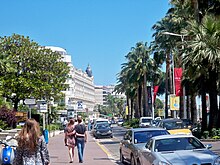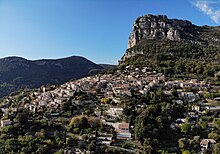French Riviera
Côte d'Azur is originally a nickname given by France to the County of Nice after its annexation in 1860, because the climate was similar to that of the north of Italy, even in winter, with "a sky as blue as its sea".With the arrival of the railway in the mid-19th century, it became the playground and vacation spot of British, Russian, and other aristocrats, such as Queen Victoria, Tsar Alexander II and King Edward VII, when he was Prince of Wales.In the first half of the 20th century, it was frequented by artists and writers, including Pablo Picasso, Henri Matisse, Francis Bacon,[3] Edith Wharton, Somerset Maugham and Aldous Huxley, as well as wealthy Americans and Europeans.[9] High-speed trains serve the coastal region and inland to Grasse, with the TGV Sud-Est service reaching Nice-Ville station in five and a half hours from Paris.It is home to a high tech and science park (French: technopole) at Sophia-Antipolis (north of Antibes) and a research and technology centre at the University of Nice Sophia Antipolis.[11] As a tourist centre, the French Riviera benefits from 310 to 330 days of sunshine per year, 115 kilometres (71 miles) of coastline and beaches, 18 golf courses, 14 ski resorts and 3,000 restaurants.Primitive tools dating to between 1,000,000 and 1,050,000 years ago were discovered in the Grotte du Vallonnet, near Roquebrune-Cap-Martin, with stones and bones of animals, including bovines, rhinoceros, and bison.[23] Stone dolmens, monuments from the Bronze Age, can be found near Draguignan, while the Valley of Marvels (Vallée des Merveilles) near Mount Bégo, at 2,000 m (6,600 ft) elevation, is presumed to have been an outdoor religious sanctuary, having over 40,000 drawings of people and animals, dated to about 2000 BC.[24] Beginning in the 7th century BC, Greek sailors from Phocaea in Asia Minor began to visit and then build emporia along the Côte d'Azur.The territory was called the Comté de Nice after 1526, and thereafter its language, history and culture were separate from those of Provence until 1860, when it was re-attached to France under Napoleon III.Until the end of the 18th century, the area later known as the Côte d'Azur was a remote and impoverished region, known mostly for fishing, olive groves and the production of flowers for perfume (manufactured in Grasse).At about the same time, a Scottish doctor, John Brown, became famous for prescribing what he called climato-therapy, a change in climate, to cure a variety of diseases including tuberculosis, known then as consumption.Blanc arranged for steamships and carriages to take visitors from Nice to Monaco, and built hotels, gardens and a casino in a place called Spélugues.By the end of the 19th century the Côte d'Azur began to attract artistic painters, who appreciated the climate, the bright colors and clear light.Industrialist John Pierpont Morgan gambled at Monte Carlo and bought 18th-century paintings by Fragonard in Grasse – shipping them to the Metropolitan Museum in New York.Dancer Isadora Duncan frequented Cannes and Nice, but died in 1927 when her scarf caught in a wheel of the Amilcar motor car in which she was a passenger and strangled her.The writer F. Scott Fitzgerald first visited with his wife Zelda in 1924, stopping at Hyères, Cannes and Monte Carlo – eventually staying at Saint-Raphaël, where he wrote much of The Great Gatsby and began Tender Is the Night.The English playwright and novelist Somerset Maugham also became a resident in 1926, buying the Villa La Mauresque toward the tip of Cap Ferrat, near Nice.Following D-Day in Normandy, Operation Dragoon (initially Operation Anvil), the code name for the Allied invasion of Southern France, commenced on 15 August 1944, when American parachute troops landed near Fréjus, and a fleet landed 60,000 troops of the American Seventh Army and French First Army between Cavalaire and Agay, east of Saint-Raphaël.During the 1960s, the Mayor of Nice, Jacques Médecin, decided to reduce the dependence of the Riviera on ordinary tourism, and to make it a destination for international congresses and conventions.At the end of August 1997, Princess Diana and Dodi Fayed spent their last days together on his father's yacht off Pampelonne Beach near Saint-Tropez[citation needed], shortly before they died in the Alma Tunnel in Paris.THE TIMES[32] The French Riviera is mostly subtropical, featuring a Mediterranean climate, with sunny, hot, dry summers and mild winters.The French Riviera is one of the mildest locations in the world for its latitude, owing to the Gulf Stream which moderates the temperatures in Western Europe, particularly in winter and the warming effect of the Mediterranean Sea.The département of Var (which includes Saint-Tropez and Hyères) has a climate slightly warmer, drier and sunnier than Nice and Alpes-Maritimes, but is less sheltered from the wind.The mistral, which brings cold and dry air down from the upper Alpine regions via the Rhône valley and extends with diminishing intensity along the Côte d'Azur, blows frequently during the winter.













Côte d'Azur (disambiguation)Blue Coast RecordsFrenchOccitanRivieraSaint-Jean-Cap-FerratSaint-TropezMonte Carlo CasinoPrincipality of MonacoCountryFranceMonacoProvençalMediterraneanAlpes-MaritimesdepartmentMassif de l'EsterelMentonFrance–Italy borderToulonProvence-Alpes-Côte d'Azurregionsemi-enclaveCap-d'AilBeaulieu-sur-MerVillefranche-sur-MerAntibesJuan-les-PinsCannesTheoule-sur-MerItalianLigurian territoryCounty of NiceMistralTramontaneLanguedocProvenceItalian RivieraresortQueen VictoriaTsar Alexander IIKing Edward VIIPrince of WalesRothschild familyPablo PicassoHenri MatisseFrancis BaconEdith WhartonSomerset MaughamAldous HuxleyWorld War IIElton JohnBrigitte BardotmétropoleNice-Côte d'AzurNice Côte d'Azur AirportCharles de Gaulle AirportOrly AirportPromenade des AnglaisMandelieuA8 autorouteRoute nationale 7GrasseSud-EstNice-Ville stationSophia-AntipolisUniversity of Nice Sophia AntipolisyachtingsuperyachtPort HerculesVentimigliaLa SpeziaStéphen LiégeardCôte-d'OrNiçardDavid DellepianeSaint-RaphaëlcalanqueHyèresVar (departement)CassisBouches-du-RhônePatricia HighsmithHistory of ProvenceprehistoricGrotte du VallonnetRoquebrune-Cap-MartinTerra AmatadolmensBronze AgeDraguignanVallée des MerveillesMount BégoPhocaeaAsia MinoremporiaEtruscansPhoeniciansAugustusLa TurbieTrophy of the AlpsamphitheatresCimiezFréjusFréjus CathedralGermanic peoplescathedralsbishopricsmonasteryLerins MonasteryWestern Roman EmpireVisigothsBurgundiansOstrogothsSaracensNormansnew kingdom of ProvenceBosonidsCatalanselder branchyounger branchGrimaudHouse of GrimaldiCagnes-sur-MerAlbert IIPrince of Monaco


